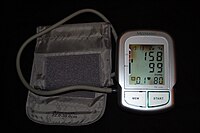
Photo from wikipedia
Male sex I n this analysis of the China Nationwide Ambulatory and Home Blood Pressure Registry, Zhang et al. document that cigarette smoking is associated with an increased odds of… Click to show full abstract
Male sex I n this analysis of the China Nationwide Ambulatory and Home Blood Pressure Registry, Zhang et al. document that cigarette smoking is associated with an increased odds of masked hypertension during the waking hours, as measured by ambulatory blood pressure monitoring (ABPM) and home blood pressure monitoring (HBPM) [1]. The risk is the highest in heavy smokers, individuals aged 55 years or older, and individuals with normal to high-normal office BP. The results corroborate previous evidence that smoking may increase the risk of masked hypertension [2], but also provide several new pieces of information that may help improve the screening and identification of individuals with this condition. Masked hypertension is known to enhance the chance of developing a fatal or nonfatal cardiac or cerebrovascular disease, with a risk comparable to that of sustained hypertension [2–4]. It is a complex phenomenon that recognizes several promoting factors that interplay to its determination (Table 1) [2,5–7]. As confirmed by the study of Zhang and coworkers [1], cigarette smoking is an important determinant of masked hypertension and particularly of daytime masked hypertension. People smoke when they are awake, and although the pressor and tachycardic effect of one single cigarette is relatively long-lasting (15–30 min), it is repeated over and over during the daytime hours in frequent smokers. According to an early study, smoking up to two cigarettes per hour contributes to an average day-time BP level increment of 5–6mmHg (Fig. 1) [8]. In their study, Zhang and coworkers determined masked hypertension using two different out-of-office BP-measuring methods in the same individuals [1], obtaining a prevalence of masked hypertension with daytime ABPM of 19% and with evening HBPM of 15%. This difference is expected since when both methodologies are applied to the same individuals, the ABPM has the advantage of a greater sensitivity compared with HBPM [2,9]. In smokers, HBPM may resemble more closely the BP measurement in the
Journal Title: Journal of Hypertension
Year Published: 2020
Link to full text (if available)
Share on Social Media: Sign Up to like & get
recommendations!